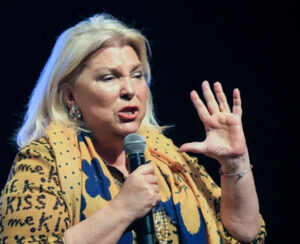
Unas 35 millones de personas están habilitadas para definir en las urnas este domingo quién se convertirá en el nuevo jefe de Estado a partir del 10 de diciembre: Sergio Massa, de Unión por la Patria, o Javier Milei, de La Libertad Avanza.
La incógnita sobre quién será el próximo Presidente de la Argentina quedará revelada este domingo, cuando concluya el balotaje en el que podrán sufragar unas 35 millones de personas y se conozcan los resultados de la última instancia electoral del año, que definirá cuál de los dos candidatos más votados en octubre pasado será jefe de Estado a partir del 10 de diciembre: Sergio Massa, de Unión por la Patria (UxP) o Javier Milei, de La Libertad Avanza (LLA).
Con la disputa en las urnas de dos proyectos de país antagónicos, esta segunda vuelta electoral pondrá fin al proceso con el que los ciudadanos decidirán quiénes reemplazarán en el Gobierno a Alberto Fernández y a Cristina Fernández de Kirchner para el período 2023-2027, es decir la renovación de los cargos del Poder Ejecutivo: Presidente y Vicepresidente.
El camino hacia esta definición se inició en agosto último, con las primarias abiertas, simultáneas y obligatorias (PASO), y continuó el 22 de octubre, con las presidenciales.
Con esas dos votaciones, el electorado fue perfilando el orden de sus preferencias político-partidarias hasta este último tramo, en el que sólo habrá dos boletas en el cuarto oscuro: la de Unión por la Patria, con la fórmula presidencial Massa-Agustín Rossi, y la de La Libertad Avanza, con el binomio Milei-Victoria Villarruel.
Los que quedaron en el camino
El tamiz electoral iniciado tres meses atrás dejó fuera de carrera a 19 fórmulas presidenciales que no superaron el piso del 1,5% de votos necesario para participar de las generales.
Los resultados de las PASO de agosto mostraron una paridad de tres tercios, más allá de que LLA logró la mayor cantidad de votos, seguido por Juntos por el Cambio (JxC) y, en un tercer lugar, UxP.
Algo más de dos meses después, en las generales de octubre, el oficialista UxP revirtió esos números y Massa se posicionó como el candidato presidencial más elegido con casi 37 puntos. Milei salió segundo, con algo menos del 30%, y la postulante presidencial de JxC, Patricia Bullrich, apenas bordeó el 24% y quedó fuera del balotaje.
Esos números confirmaron la realización del balotaje porque ninguno de los aspirantes más votados logró el puntaje legal necesario para consagrarse Presidente en primera vuelta.
Pero además los resultados astillaron los acuerdos partidarios puertas adentro de JxC, con el apoyo unilateral de un sector del PRO -alineado con Bullrich y con el expresidente Mauricio Macri- al postulante partidario y el enojo del resto de los miembros de la coalición: la UCR y la Coalición Cívica (CC).
Los comicios de octubre mostraron también, no sólo un viraje en las preferencias, sino un mayor caudal de votantes: hubo un 8% más de personas que acudió a las urnas en octubre (77,04%), en comparación con el 69% que lo hizo en las PASO de agosto.
Dos opciones, un presidente
Este domingo el electorado de los 24 distritos del país deberá optar sólo entre dos boletas: la de Massa o la de Milei y quien obtenga la mayor cantidad de votos afirmativos será el nuevo Presidente de la Argentina.
Pero esa decisión, además, dejará en evidencia cómo se redireccionaron los apoyos luego de que en octubre quedaran fuera de competencia los otros tres postulantes presidenciales Bullrich, de JxC; Myriam Bregman, del Frente de Izquierda y de Trabajadores-Unidad (FIT-U), y Juan Schiaretti, de Hacemos por Nuestro País (HpNP).
El desafío y los esfuerzos estuvieron puestos, tanto para UxP como para LLA, en captar el favoritismo en las urnas y convencer a los votantes que en octubre eligieron otras fuerzas.
Argentina faces the possibility of choosing between two antagonistic models for the country.
Approximately 35 million people are eligible to decide at the polls this Sunday who will become the new head of state starting December 10: Sergio Massa, from Union for the Homeland, or Javier Milei, from Liberty Advances.
The mystery of who will be the next President of Argentina will be revealed this Sunday when the runoff concludes. About 35 million people will cast their votes, and the results of the last electoral instance of the year will determine which of the two candidates, who received the most votes in the past October elections, will be the head of state starting December 10: Sergio Massa from Union for the Homeland (UxP) or Javier Milei from Liberty Advances (LLA).
With the electoral confrontation between two opposing country projects, this second round will conclude the process in which citizens decide who will replace Alberto Fernández and Cristina Fernández de Kirchner in the government for the 2023-2027 term, meaning the renewal of the executive branch positions: President and Vice President.
The journey toward this decision began last August with the open, simultaneous, and obligatory primaries (PASO) and continued on October 22 with the presidential elections.
Through these two votes, the electorate shaped the order of their political party preferences up to this final stretch, where only two ballots will be available in the voting booth: one for Union for the Homeland, with the presidential ticket Massa-Agustín Rossi, and the other for Liberty Advances, with the pair Milei-Victoria Villarruel.
Those who were left behind The electoral sieve initiated three months ago eliminated 19 presidential tickets that did not surpass the 1.5% vote threshold required to participate in the general elections.
The results of the August primaries showed a three-way parity, even though LLA garnered the highest number of votes, followed by Together for Change (JxC), and, in third place, UxP.
A little over two months later, in the October general elections, the ruling party UxP reversed those numbers, and Massa positioned himself as the most chosen presidential candidate with almost 37 points. Milei came in second with just under 30%, and the JxC presidential candidate, Patricia Bullrich, barely reached around 24% and did not make it to the runoff.
These numbers confirmed the runoff because none of the most voted candidates achieved the legal score required to become President in the first round.
Furthermore, the results fractured internal party agreements within JxC, with unilateral support from a sector of PRO -aligned with Bullrich and former President Mauricio Macri- for the party’s candidate and the discontent of the rest of the coalition: the Radical Civic Union (UCR) and the Civic Coalition (CC).
The October elections also showed not only a shift in preferences but also a higher voter turnout: there was an 8% increase in the number of people who voted in October (77.04%) compared to the 69% in the August primaries.
Two options, one president This Sunday, voters from the 24 districts of the country will have to choose only between two ballots: Massa or Milei. The candidate with the most affirmative votes will be the new President of Argentina.
However, this decision will also reveal how the support shifted after the other three presidential candidates—Bullrich from JxC, Myriam Bregman from the Left Front and Workers-Unity (FIT-U), and Juan Schiaretti from We Do for Our Country (HpNP)—were eliminated from the competition in October.
The challenge and efforts were focused, both for UxP and LLA, on winning favor in the polls and convincing voters who chose other forces in October.
阿根廷面临选择两种对立国家模式的可能性。
大约有3500万人有资格在这个星期天决定谁将从12月10日开始成为新的国家元首:Union por la Patria的Sergio Massa,或者是La Libertad Avanza的Javier Milei。
关于谁将成为阿根廷下一任总统的谜团将在这个星期天揭晓,当时将有大约3500万人投票,并且将得知今年最后一轮选举的结果。这将决定在2023年10月10日开始,去年10月最后一轮选举中获得最多选票的两位候选人中的哪位将成为国家元首:Union por la Patria的Sergio Massa(UxP)还是La Libertad Avanza的Javier Milei(LLA)。
由于在选民中存在两种对立的国家项目,这次第二轮选举将结束这个过程,公民们将决定谁将在2023年至2027年期间取代阿尔贝托·费尔南德斯和克里斯蒂娜·费尔南德斯·德基什内尔担任政府职务,即执行部门的职位:总统和副总统。
这一决定的旅程始于去年8月的开放、同步和强制性初选(PASO),并于10月22日继续进行总统选举。
通过这两次投票,选民塑造了他们的政党偏好的顺序,一直到最后阶段,这里只有两张选票可用于投票站:Union por la Patria的总统提名Massa-Agustín Rossi,以及La Libertad Avanza的总统Milei-Victoria Villarruel。
被淘汰的候选人 三个月前开始的选举筛选淘汰了19个未能超过1.5%选票门槛以参加总统选举的总统候选人。
8月初选的结果显示了三分之一的平衡,尽管La Libertad Avanza获得了最多的选票,紧随其后的是Juntos por el Cambio(JxC),在第三位是Union por la Patria。
两个多月后的10月大选中,执政党Union por la Patria扭转了这些数字,Massa以将近37点的得票率成为最受欢迎的总统候选人。Milei以略低于30%的得票率获得第二名,JxC总统候选人Patricia Bullrich仅获得了24%左右,未能进入决赛。
这些数字证实了决赛的进行,因为最受欢迎的候选人没有一个在第一轮中获得法定分数来成为总统。
此外,10月的选举还破坏了JxC内部党内协议,一部分PRO – 与Bullrich和前总统Mauricio Macri站在一边的人支持该党的候选人,而联盟的其他成员 – UCR和Coalición Cívica(CC)则感到不满。
10月的选举不仅显示了选民偏好的转变,还有更高的选民投票率:与8月份的69%相比,10月有8%的人前往投票站(77.04%)。
两个选项,一个总统 这个星期天,全国24个地区的选民必须在Massa或Milei之间选择。得到最多肯定票的候选人将成为阿根廷的新总统。
然而,这个决定还将揭示在其他三位总统候选人 – 来自JxC的Bullrich,来自左翼和工人-团结(FIT-U)的Myriam Bregman以及来自Hacemos por Nuestro País(HpNP)的Juan Schiaretti – 在10月被淘汰后支持如何重新定位。
对于UxP和LLA而言,挑战和努力都集中在赢得选民的支持,并说服那些在10月选择其他政党的选民。











Noticias relacionadas
La semana arranca con tiempo inestable
Taller Universitario: Reforzá tus técnicas de estudio, oratoria y habilidades para el aprendizaje
¡Reconquista celebró su 152º Aniversario de Fundación!